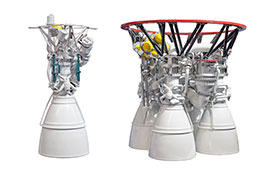 Master Bond liquid, paste, film adhesives have played an integral role in the development and assembly of key parts in specific rocket applications. Our high quality formulations are employed on launch vehicles that carry payloads such as satellites, crewed spaceships, interplanetary space probes and orbital space exploration spacecraft. Master Bond grades have been compounded to meet stringent requirements to enhance the performance of the frame, payload, systems, propulsion and stability/control of solid-fuel, liquid-propellant, hybrid, monopropellant rockets. These exceedingly sophisticated rockets have enabled scientists including astronomers, physicists, climatologists, chemists, biologists to acquire valuable information that otherwise would be unobtainable through ground based observations.
Master Bond liquid, paste, film adhesives have played an integral role in the development and assembly of key parts in specific rocket applications. Our high quality formulations are employed on launch vehicles that carry payloads such as satellites, crewed spaceships, interplanetary space probes and orbital space exploration spacecraft. Master Bond grades have been compounded to meet stringent requirements to enhance the performance of the frame, payload, systems, propulsion and stability/control of solid-fuel, liquid-propellant, hybrid, monopropellant rockets. These exceedingly sophisticated rockets have enabled scientists including astronomers, physicists, climatologists, chemists, biologists to acquire valuable information that otherwise would be unobtainable through ground based observations.
Master Bond structural adhesive systems for rocket production are designed to offer improved load bearing capacity, resistance to cyclic fatigue and seal against liquid, gas contaminants. They feature extraordinary shear/peel strength properties between similar/dissimilar substrates such as aluminum, nickel alloys, titanium, stainless steel, chromium, carbon composite substrates. Engineering weight reduction for rockets has been advantageous in reducing fuel consumption and allowing heavier payloads. Significant progress has been made by utilizing toughened compositions for joining materials with mismatched coefficients of thermal expansion and contraction. This is especially
important since rocket components are subjected to thermal cycling which can cause cracking, delamination, crazing, mechanical failure in many instances. It is essential to note that electronic, electrical, chemical, biological payloads containing compact delicate instruments including spectrometers, imaging systems, magnetometers, altimeters, microwave humidity sounder, infrared sensors will also need to take into account the detrimental effects caused by thermal cycling.
Other critical factors need to be evaluated and tested before selecting the most suitable Master Bond compound for rocket components/parts. Preventing adhesive degradation while providing protection from the exceedingly hostile and damaging effects of space is a most difficult task. Formidable obstacles must be overcome. In order for rockets to accomplish their mission successfully, it is compulsory during equipment fabrication that only bonding agents that can withstand exposure to vibration, shock, pressure, extreme heat/cold, ultraviolet radiation, be deployed. Flammability, toxicity, low outgassing concerns must be appraised. Low outgassing is among the most crucial attribute to mitigate any harm associated from the release of volatiles, especially on optical surfaces in vacuum environments. NASA low outgassing approved systems consist of one and two component epoxies and silicones. These electrically insulative, thermal conductive, electrically conductive compositions exhibit distinct characteristics ranging from optical clarity, dimensional stability, low shrinkage to cryogenic serviceability, low coefficient of thermal expansion, chemical inertness. It is imperative to note that Master Bond products have been at the forefront in attaining innovative products adept in improving reliable, efficient, dependable operation of parts/components in space for different sized, shaped rockets.
In addition to space flight, Master Bond adhesive systems have been involved in the manufacturing of rockets for multiple different purposes. One major area is for military weaponry. It is able to attack both air and ground targets with explosive payloads. Those with guidance systems are referred as missiles. Emergency flares used to rescue ships and ejection seats for escape from military aircraft are propelled by solid rockets. Rocket trains and cares are supplementary alternatives.

